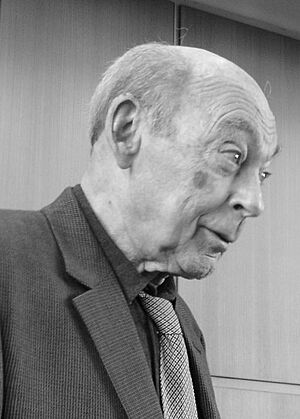János Starker facts for kids
Quick facts for kids
János Starker
|
|
|---|---|

Starker in 2009
|
|
| Born | July 5, 1924 Budapest, Hungary
|
| Died | April 28, 2013 (aged 88) Bloomington, Indiana, U.S.
|
| Occupation | Cellist |
János Starker (born July 5, 1924 – died April 28, 2013) was a famous cellist. He was born in Hungary and later became an American citizen. Many people think he was one of the greatest cellists ever. From 1958 until he passed away, he taught music at Indiana University. He was a very respected professor there.
Contents
János Starker's Life
A Young Musical Genius
János Starker was born in Budapest, Hungary. His father was from Poland, and his mother was from the Russian Empire. Both of his parents were Jewish. János had two older brothers who played the violin. Before his sixth birthday, János was given a cello. He was a true child prodigy, meaning he was incredibly talented at a very young age.
He gave his first public performances when he was only six and seven years old. He went to the Franz Liszt Academy of Music in Budapest. There, he studied with a teacher named Adolf Schiffer. János made his official debut at the Academy when he was 11. He even started teaching other children when he was just eight years old. By the time he was 12, he had five students!
Some of his biggest influences included Leo Weiner, a composer who taught chamber music. Famous composers like Zoltán Kodály, Béla Bartók, and Ernő Dohnányi also taught at the Liszt Academy. When János was 13, he played a cello piece for Dohnányi. The composer himself played the piano for János.
János had his first professional concert at age 14. He played the Dvořák concerto with very short notice. The original soloist couldn't play, so János stepped in. He left the Liszt Academy in 1939. He spent most of World War II in Budapest. Because he was so young, János avoided the terrible fate of his older brothers. They were forced into labor and died during the war. János himself spent three months in a difficult internment camp.
Starting His Career
After the war ended, Starker became the main cellist for the Budapest Opera. He also played for the Budapest Philharmonic Orchestra. In 1946, Starker left Hungary. He performed a successful concert in Vienna. Then, he stayed there to get ready for the Geneva Cello Competition. He won a bronze medal at this competition in October 1946.
After the competition, Starker spent a year in Paris. He worked hard to improve his cello technique. He felt like he had been playing without truly understanding how. At the end of his time in Paris, he made his first recording of Kodaly's Sonata for solo cello. This recording won him a special award called the Grand Prix du Disque. He recorded this piece three more times later in his career.
In 1948, Starker moved to the United States. He became the main cellist for the Dallas Symphony Orchestra. Then, in 1949, he moved to New York City. There, he was the principal cellist for the Metropolitan Opera. While in New York, Starker made his first recordings of the famous Bach Cello Suites.
In 1953, Starker became the main cellist for the Chicago Symphony Orchestra. This happened when Fritz Reiner became their music director. In 1958, Starker moved to Bloomington, Indiana. He lived there for the rest of his life. At the Indiana University Jacobs School of Music, he became a professor. He also continued his solo career, performing concerts around the world. Some of his students became famous cellists too, like Tsuyoshi Tsutsumi and Maria Kliegel.
His Recorded Music
János Starker made over 150 recordings during his career. He recorded the Bach solo cello suites five different times. His last recording of these suites was in 1997. For this recording, he won a Grammy Award, which is a very important music award. He was also nominated for a Grammy for his 1989 recording of music by David Popper.
Several composers wrote cello concertos especially for him. These included David Baker, Antal Doráti, and Miklós Rózsa. He recorded the Konzertstück for Cello and Orchestra by Ernő Dohnányi twice. This was the same piece he had played for the composer when he was 13.
His Cellos
From 1950 to 1965, Starker played and recorded on a cello called the Lord Aylesford Stradivarius. This was the largest instrument ever made by the famous craftsman Antonio Stradivarius. In 1965, Starker bought another cello. It was a Matteo Goffriller cello, made in Venice around 1705. This cello was known as the "Ivor James Goffriller." Starker later renamed it "The Star" cello.
What People Said About Him
Many documentaries, articles, and newspaper stories praised János Starker's amazing skill. He also published many books and musical scores. His autobiography, The World of Music According to Starker, was published in 2004.
How He Played
Starker's playing style was very strong and showed incredible technical skill. His students said his technique focused on long, smooth notes. He made very little noise when moving his left hand on the cello. This resulted in clear, pure sounds, where "each note sounding like a jewel." Starker himself described his sound as "centered" and "focused."
He was known for being able to create a huge range of sounds and tones. He didn't use a lot of vibrato, which is a wavering sound some musicians use. He thought too much vibrato could hide bad playing. He preferred to let the music itself create the emotion. He often quoted his friend, György Sebők, who said, "Create excitement. Don't get excited." This meant he wanted his playing to be exciting, but he stayed calm and focused on stage.


